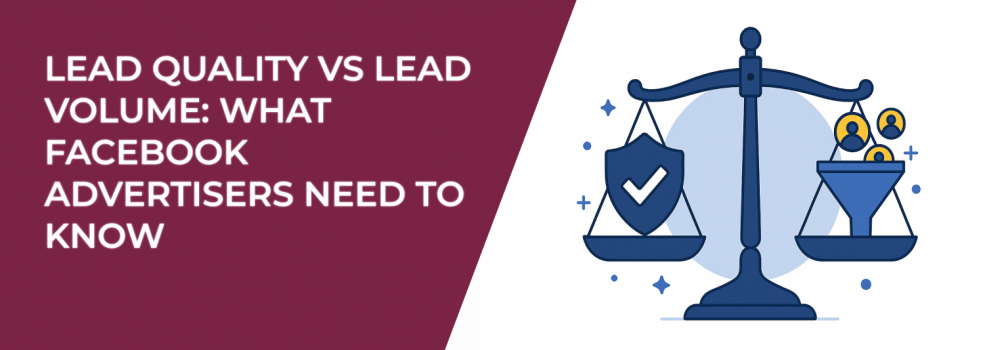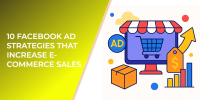If you’re running Facebook ads, you’ve probably asked yourself this: should I focus on getting more leads, or should I focus on getting better leads? On the surface, having a long list of leads looks exciting. But what if most of those people never answer the phone or buy anything?
That’s the real difference between lead volume and lead quality. And knowing how to balance the two is what separates profitable advertisers from those who burn through their budgets.
What Do Lead Quality and Lead Volume Really Mean?
Let’s keep it simple.
-
Lead Volume means the total number of people who respond to your ad, fill out a form, or download your offer. The bigger the number, the longer the list.
-
Lead Quality means the likelihood that those people will actually buy. High-quality leads are interested, have the budget, and are ready to take action.
Here’s the point: 1,000 names on a spreadsheet might look impressive, but if none of them ever open their wallets, what did you really gain? In contrast, a smaller pool of 100 leads who genuinely care about your offer can turn into a steady stream of paying customers.
Why Chasing Lead Volume Can Backfire
A lot of advertisers get hooked on numbers. It feels great when your campaign delivers hundreds or even thousands of new contacts. But that “high” can be short-lived.
When you chase volume alone, you often end up with problems like:
-
Low conversion rates: Many of those leads were never going to buy in the first place.
-
Sales team burnout: Your reps spend hours chasing uninterested people.
-
Wasted ad spend: Cost per acquisition climbs, while your ROI shrinks.
So while volume looks good on a report, it can actually be damaging if the quality isn’t there. Would you rather your sales team chase 500 cold leads or 50 people who are already warmed up?
Why Quality Leads Matter More
Now let’s flip the coin. When you put your energy into attracting high-quality leads, you see benefits across the board.
-
Higher conversion rates: More leads turn into customers, which means your campaigns are directly driving revenue.
-
Easier sales process: Your team spends less time convincing and more time closing.
-
Longer-term value: The right customers often stick around, buy again, and refer others.
-
Better ROI: Every dollar you spend brings in more measurable return.
This doesn’t mean you should ignore volume altogether — your pipeline needs to stay healthy. But if you’re measuring success only by how many leads you’re generating, you may be missing the bigger picture.
How to Get Better Leads on Facebook
You want leads who don’t just click but convert. That requires a different approach than simply casting the widest net. Below are practical strategies that can help.
1) Targeting That Filters, Not Just Finds
The first step is to aim at the right people, not just the largest audience. With Facebook, you can build Custom Audiences from people who’ve already interacted with your brand, like website visitors, video watchers, or past customers. These audiences are warm by default.
Once you have that base, you can create Lookalike Audiences that expand your reach but still carry similar traits to your best buyers. Don’t forget exclusions — cut out past leads who didn’t convert, irrelevant job seekers, or freebie hunters. If your team wants a deeper walkthrough of targeting fundamentals and pro tips, point them to Facebook Ad Targeting 101: How to Reach the Right Audience.
This way, you’re not just filling your pipeline with anyone who clicks, but with people who have real potential to buy.
2) Messaging That Qualifies Up Front
Your ad copy can do a lot of heavy lifting when it comes to filtering leads. The more specific you are about who your product or service is for, the better.
Think of your ad as a mini gatekeeper. When you mention budget ranges, industries served, or service areas, you’re signaling to the right people that they’re in the right place — and gently pushing away the wrong ones. A call-to-action like “Book a free 15-minute strategy call” is far more effective than a vague “Learn More,” because it sets expectations right away.
3) Lead Forms and Landing Pages That Screen Smartly
Too many advertisers treat forms as a simple “name and email grab.” But forms can be powerful filters if you build them strategically.
With Instant Forms, use the “Higher intent” option and add a confirmation step. Ask qualifying questions — two to four is enough. For example, “What’s your budget?” or “What’s your timeline?” or “Where are you located?” A free-text question like “What’s your biggest challenge?” is also a great way to separate serious prospects from casual clickers. For practical, conversion-focused tweaks, share How to Optimize Facebook Lead Ads for Higher Conversion Rates with your team.
If you’re sending traffic to a landing page, keep the messaging clear and aligned with your ad. Use social proof like testimonials or logos to build trust, and place your form where it’s easy to find. Every field you add should either help sales follow up or weed out people who aren’t a fit. If it doesn’t do either, leave it out.
4) Teach the Algorithm With Better Signals
Facebook’s algorithm is smart, but it can only optimize based on what you tell it. If you optimize for “leads,” it will give you the cheapest leads possible — and cheap often means low quality.
Instead, optimize for the end result you care about: purchases, booked calls, or demo completions. Pass value data back through your pixel or Conversion API, so Facebook learns which conversions matter more. Upload offline conversions too — like closed deals from your CRM — so the system gets a full picture of your real buyers.
5) Retargeting That Nudges, Not Nags
Leads rarely convert on the first click. That’s where retargeting shines. But instead of blasting the same ad endlessly, tailor your retargeting by timeframe and intent.
Hot leads (1–7 days) need urgency or reminders. Warm leads (8–30 days) might need education or social proof. Cooler leads (31–90 days) respond to softer content like guides or comparison ads. By matching your message to where the lead is in their journey, you build trust without overwhelming them. For a clean, step-by-step setup, bookmark How to Set Up Facebook Retargeting.
6) Budgeting and Scaling That Protects Quality
Your budget strategy also shapes who sees your ads. Spend most of your budget on proven campaigns, but always leave a slice for testing new audiences and creatives. This keeps your campaigns fresh and helps you find new winners.
Start with lowest-cost bidding to give Facebook room to learn, then experiment with cost caps once you know your target CPA. And when you scale, do it gradually — a 15–20% increase every few days is safer than doubling your budget overnight.
7) Speed-to-Lead and Follow-Up
Even the best targeting won’t save you if your follow-up is slow. Leads go cold quickly.
Aim to respond within five minutes during business hours. Route top-quality leads directly to senior reps or let them book calls through a calendar link. For leads who aren’t ready to buy, put them into a nurture sequence — a short series of emails or texts over a week or two with tips, proof, and soft offers. The faster and more relevant your response, the higher your close rate.
8) Measure What Really Matters
Cost per lead is only the beginning. If you stop there, you miss the full story.
Track the entire journey: leads → qualified leads → opportunities → customers. If only a small fraction of your leads are making it through, you likely have a quality problem. Shift your focus to cost per acquisition (CPA) and customer lifetime value (LTV). These metrics give you a much clearer picture of whether your ads are profitable.
9) Keep Testing and Refreshing
Every campaign gets stale eventually. That’s why continuous testing is essential.
When you test, change one variable at a time — like the headline, image, or offer. Give each test enough data before making a decision, then cut what doesn’t work. Keep winners running, but refresh creatives every few weeks to prevent fatigue. A steady stream of fresh content keeps your campaigns healthy.
10) Tailor Your Approach by Industry
Finally, remember that one size doesn’t fit all.
-
B2B SaaS should optimize for demo bookings, use work emails, and highlight ROI.
-
Local services should keep tight geographic targeting, use local proof, and emphasize fast response.
-
Ecommerce brands can use quizzes or product guides to capture leads, then retarget with dynamic product ads.
Different industries require different tactics, but the principles of clarity, filtering, and tracking remain the same.
Balancing Quality and Volume
Here’s the truth: you can’t survive on quality alone, and you can’t survive on volume alone. You need a mix.
-
If you sell high-ticket services, fewer but stronger leads are the way to go.
-
If you run an ecommerce store, volume plays a bigger role — but quality still keeps your cart from filling with abandoned checkouts.
-
If you’re a local business, you need a steady flow, but they must be nearby and genuinely interested.
The sweet spot is different for every advertiser. The only way to find it is by testing, tracking, and adjusting over time.
Key Takeaways
So what should you remember?
-
Big numbers don’t always mean big results.
-
Quality leads are worth more than a pile of weak ones.
-
Smarter targeting, clearer ads, and better forms all raise quality.
-
Always track beyond cost per lead — measure revenue and real ROI.
At the end of the day, Facebook ads aren’t about filling up spreadsheets. They’re about driving real business growth with the right people.
And the question you should always be asking yourself is this: are your ads creating opportunities, or just numbers?

